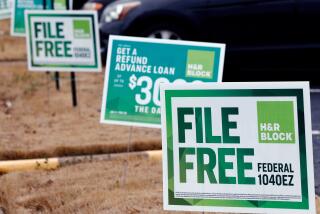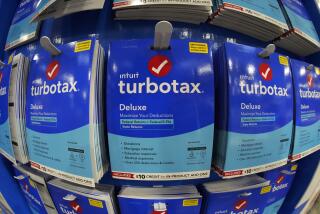2 Companies Realize Returns on Tax Software
- Share via
Cassandra Sylvester, a taxpayer services specialist in the Internal Revenue Service’s Houston office, answers only the hard questions. Her forte is the most confusing, complicated and baffling problems taxpayers may have. She sometimes spends an entire day poring over obscure IRS rulings to clarify a single clause of tax law.
But, when the queries concern a specific IRS form or a set of instructions, or when taxpayers ask her to calculate a set of numbers, her job is easier. Sylvester simply loads a copy of Turbo Tax, an income tax preparation software program published by San Diego-based ChipSoft Inc., into her personal computer and responds immediately.
“The program replaces Package X, Volume 1,” she said, lapsing into IRS jargon for the standard package of forms most taxpayers know about. “It is easier to go to the computer than do it the way we used to.”
Emerged as Leader
By making income tax preparation easier if not less painful, ChipSoft has emerged as the country’s leading publisher of microcomputer-oriented tax preparation. Competing against marketing heavyweights such as Simon & Schuster, ChipSoft holds nearly 50% of the retail market for this category, according to IMS America, a market research group near Philadelphia.
ChipSoft is not the only publisher of tax preparation software in San Diego. According to IMS, La Jolla-based HowardSoft’s Tax Preparer holds third place with 10% of the retail market.
Although nobody appears to know exactly how much revenue income tax preparation software generates, the IMS figures--which put the market through computer store sales at less than $2 million--are unrealistically low.
“We sell a lot of programs directly,” said Jim Howard, president of HowardSoft.
And, for much of the year, ChipSoft’s Turbo Tax has topped the best-seller list of PC Connection (a large mail-order operation), outselling giants such as Lotus 1-2-3 and WordPerfect.
Revenue to Top $10 Million
According to company President Mike Chipman, ChipSoft will sell 180,000 copies of its federal income tax program and another 60,000 state tax programs this year. Revenues should exceed $10 million in 1989, he said, adding that, including software for both personal users and professional tax preparers, the total market is about $60 million. Howard refused to reveal revenue figures, but said the company has 20,000 users.
Both ChipSoft and HowardSoft were established by defense industry professionals who did their own taxes--Howard, 46, holds a Ph.D. in electronics engineering and worked for 15 years at Hughes Aircraft in Los Angeles; Chipman, 42, was a programmer scientist at Scientific Applications International Corporation. The companies they founded, however, are quite different.
Chipman was bitten early by the entrepreneurial bug. For Howard, “it was a fluke; a customer drove me into it.”
In late 1983, Chipman bought his first IBM PC and decided he wanted the computer to help him prepare his tax return. He was something of a tax nut, often reading forms he didn’t even use in order to see what kind of deductions other people were getting.
When he went software shopping, he didn’t like what he found.
“I thought that everything was overpriced or underpowered,” he said.
Worked at Night
So he decided to write his own program. He wanted software that was fast and could handle what-if types of analysis for different tax scenarios. And, in the back of his mind, he knew that, if the program was good, he could use it to launch his own company.
Chipman worked on the program at night for six months. In the summer of 1984, he quit his job, setting up shop in a room behind his garage.
His wife, a teacher at Black Mountain Middle School in San Diego, couldn’t understand why he gave up his job for one that had no chance of success, Chipman said.
But, six weeks after his demonstration program to calculate the previous year’s taxes was released, it received a rave review in a major PC magazine.
“You had to scrape me off the ceiling,” Chipman recalled. “I was euphoric. It was a stroke of luck (the magazine) even had the program.”
Overnight, sales doubled to 1,000 units a month. Within nine months, the company was in the black.
Ah, the Entrepreneurial Life
The next year, Chipman wrote a program with more power aimed at the professional tax preparer, which today costs $295. The program for personal users has a suggested retail price of $75. Annual updates are half price.
Chipman began to live the fabled entrepreneurial life. He had a dozen employees working in his home. In the same room where he programmed, a woman shrink-wrapped boxes with a blow-dryer. The hallways were so stuffed with inventory that people had to walk sideways to pass. He and his wife worked 363 days that year.
Not until August, 1987, did they move to a 30,000-square-foot plant. Today the company has 85 full-time employees.
ChipSoft’s Turbo Tax success can be summed up by its patrons.
“My life is so much faster and easier since I started using it,” said John Starbuck, a licensed tax preparer in Vista for the past 25 years.
Starbuck prepares about 150 personal 1040 forms each tax season. He used to send his data to a computer service bureau in Los Angeles, which would then electronically calculate the return.
‘Gives Me More Control’
“But Turbo Tax gives me more control. And I have more free time with my motor home and sailboat,” he said.
“I do my taxes in one-third to one-quarter of the time it used to take me,” said Dennis Costarakis, office manager of Prudential Bache’s Carlsbad office and chairman of the local microcomputer investors club. He estimates that about 35% of the club members use Turbo Tax.
Chipman believes that more than 1.5 million tax returns were prepared with the program last year, including one belonging to a member of the staff at the Vatican.
With those kind of results, Chipman dreams of building a large company. A very large company. He already offers income tax programs for 41 states--the widest array in the industry. And he is considering developing related software such as a personal finance management program. Eventually, he believes, the company could gross $100 million or more.
Jim Howard doesn’t have that kind of ambition.
“We purposely don’t get into products that will increase our volume too high because then you lose the one-to-one contact with your customers,” he said. “I have a little of the small-is-beautiful orientation. I don’t want to make a lot of money as much as keep dealing with real people.”
Only If It’s Fun
Indeed, HowardSoft, whose program sells for $295, appealing primarily to professional preparers and moonlighters, stopped providing programs for several states because it was “no longer fun,” Howard said.
On the other hand, he said, the company is headquartered in an expensive ocean-front office suite in La Jolla even though it doesn’t contribute much to the business, because that is fun.
Ironically, Howard established his company for tax reasons. In 1979, he bought an Apple II computer for his children.
“I wanted to find something useful to do with it, so I wrote a real estate appraisal package and an income tax program,” he said.
To legitimately deduct the cost of the computer as a business expense, he issued a press release to the largest computer magazines, announcing the programs. They published it, and that year he sold 50 copies of the tax software.
The following year, he sold 200 programs. One was to a certified public accountant in Texas who encouraged him to pursue the business full time. In 1981, he did just that.
Customer Suggestions
Howard believes that his program contains more depth than programs that sell for less than $100. But, for him, contact with his user base is the most rewarding aspect of the business. Every year he incorporates about 200 suggestions for his customers into the program.
The future for tax preparation software looks bright.
“People eat, sleep, die and do taxes,” said Prudential Bache’s Costarakis. “And, if they don’t do their taxes, they can go to jail.”
This year, more than 2 million tax forms will be filed electronically by paid preparers. Although individuals are not yet authorized to file electronically, ChipSoft is conducting a pilot project to facilitate the move in the future.
Over the next several years, electronic filing could become popular. Not only are there fewer errors--only 3% of electronically filed returns have mistakes, contrasted with 21% of paper returns, according to the IRS--but refunds are issued within 18 days.
Still, there are some drawbacks to income tax preparation programs.
“If you have a very complex tax structure, you are doing yourself a disservice if you don’t go to a CPA,” Costarakis said.
You also might want to consider what happened to Mike Chipman himself. Once, when asked if Turbo Tax handled a certain kind of transaction, he began to rattle off all of the relevant IRS forms.
“Can you image walking around with all that worthless information in your mind?” he said.
More to Read
Inside the business of entertainment
The Wide Shot brings you news, analysis and insights on everything from streaming wars to production — and what it all means for the future.
You may occasionally receive promotional content from the Los Angeles Times.










